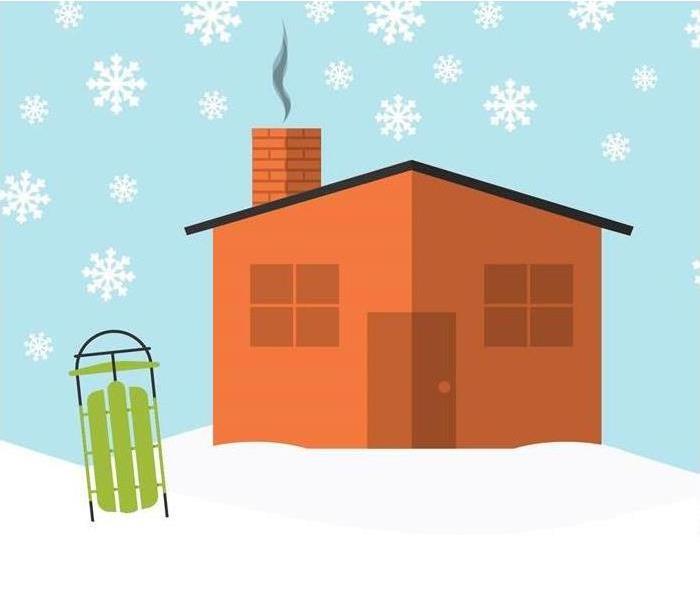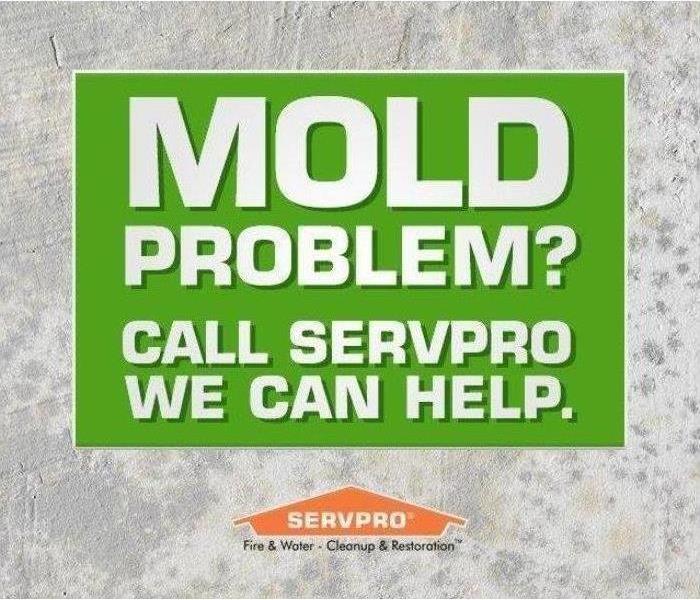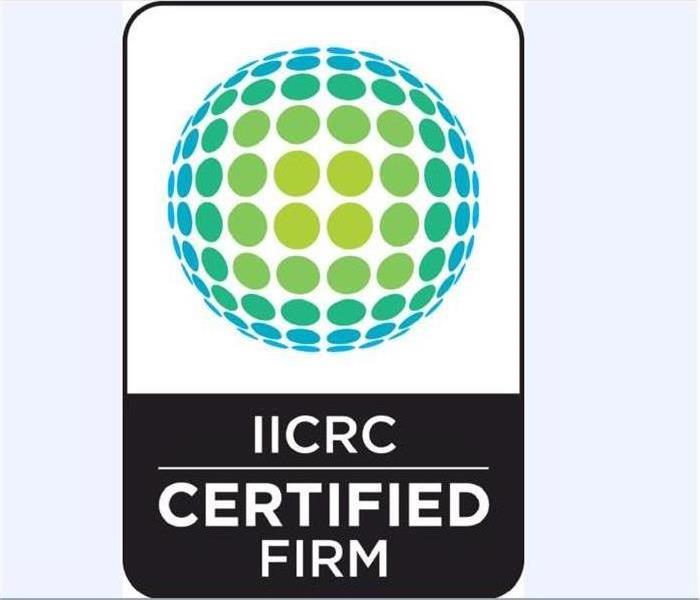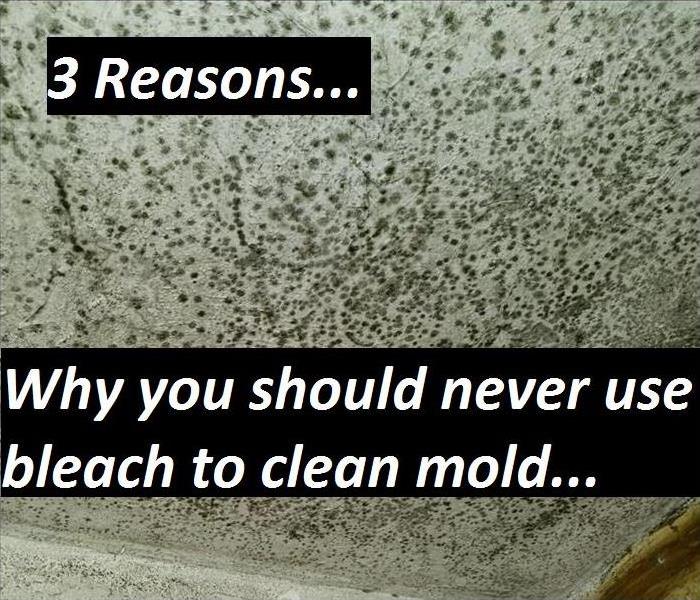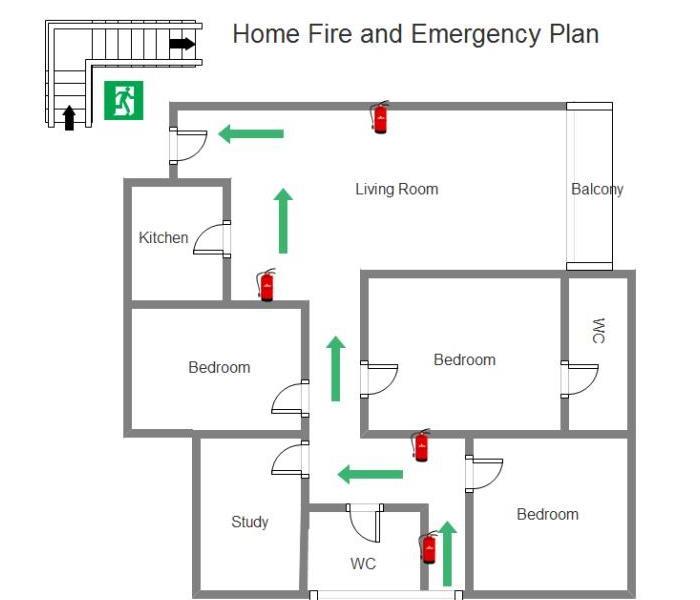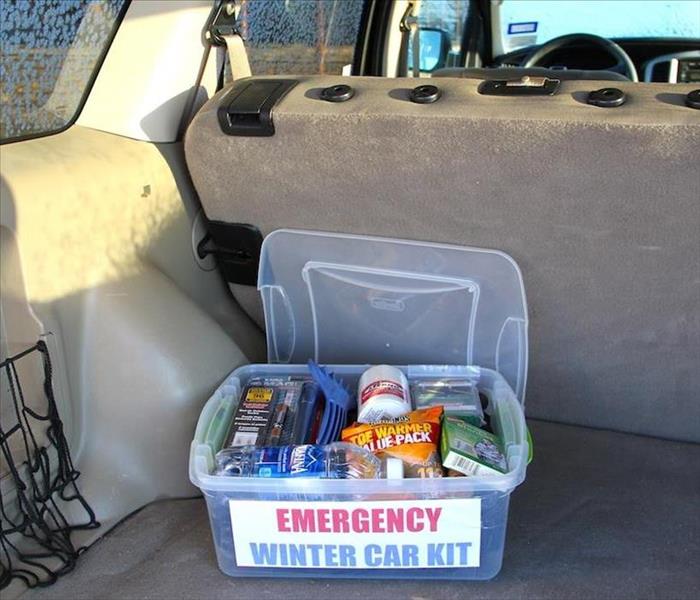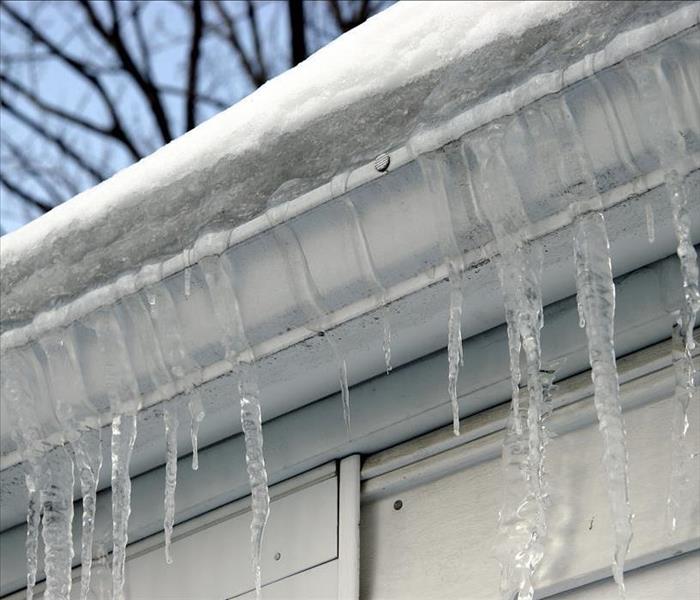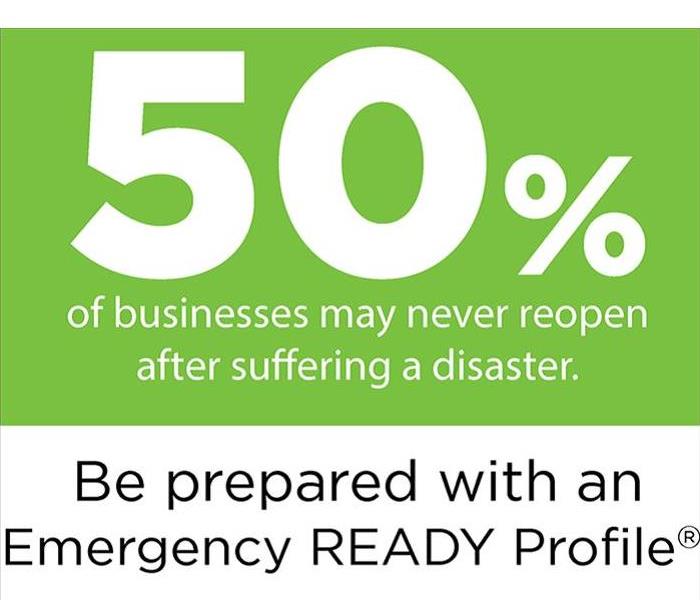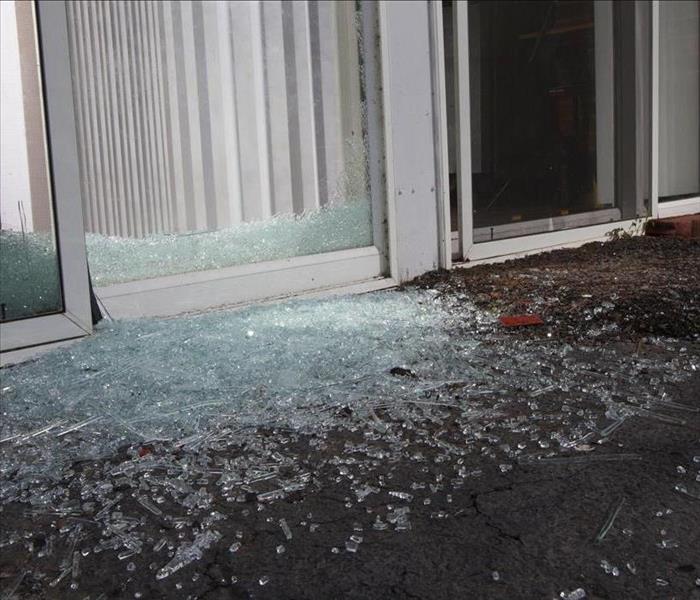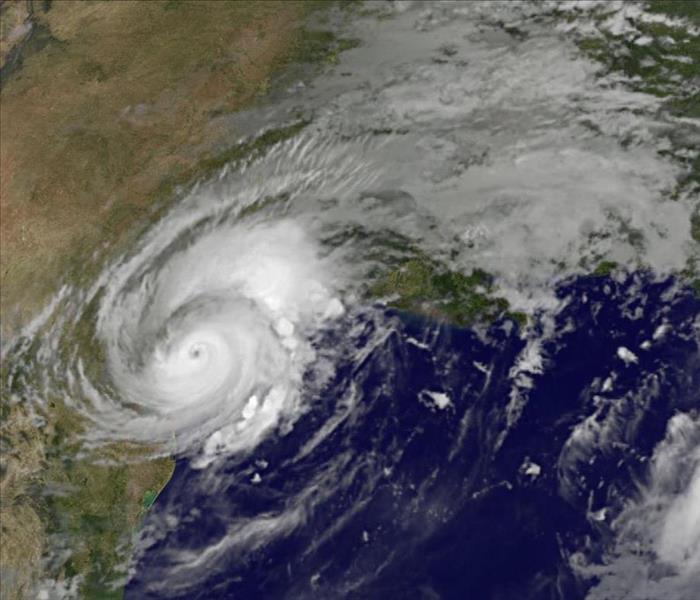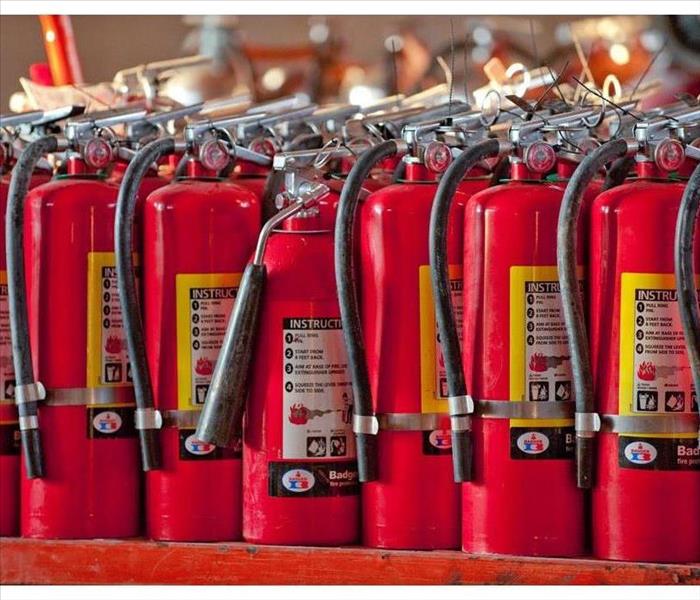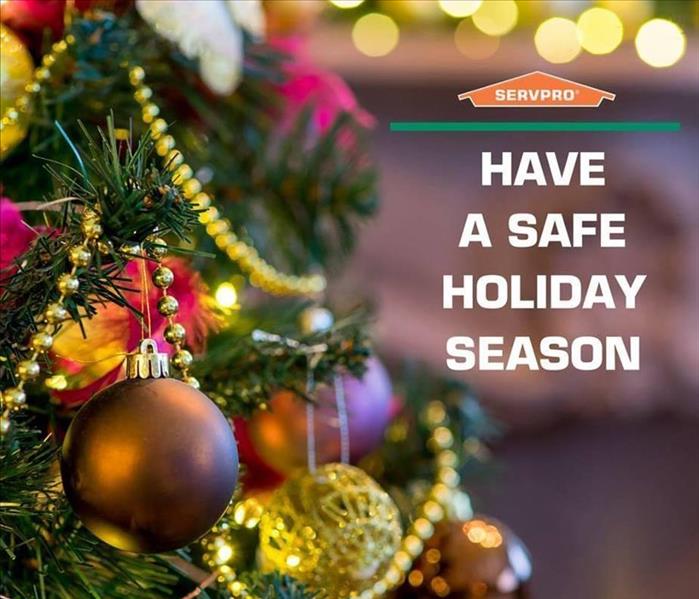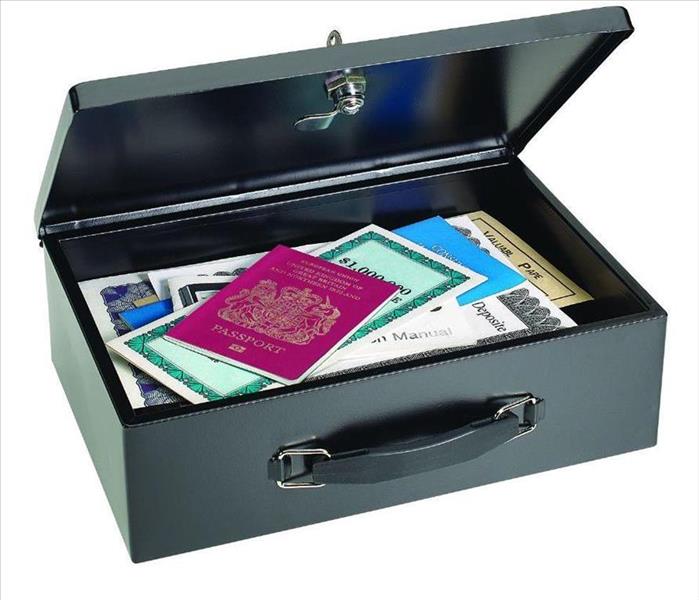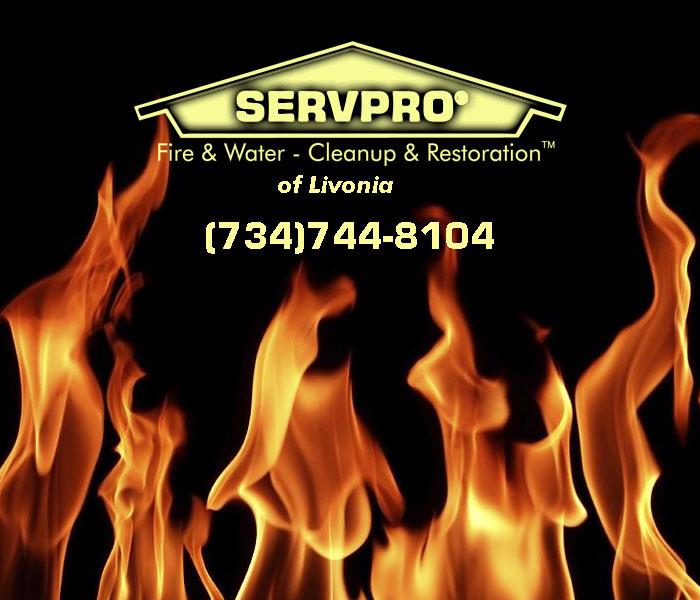Archived Blog Posts
Spring Cleaning and Repeating
3/18/2020 (Permalink)
We have all heard of spring cleaning, but this is a unique time for many in during the COVID-19 pandemic. Using this time to disinfect and deep clean could be beneficial to the overall health of your home environment as well as the personal health of those living in your home.
Cleaning tips for areas not often considered:
- Charger Cords
- Computer Keyboard and Mouse
- Remote Controls (TV & Video Game)
- Door Handles (Interior & Exterior)
- Light Switches
- Handles on Appliances and Cupboards (Kitchen, Bath & Laundry Rooms)
- Hair Brush Handles
- Furnace Filter
- Vacuum Filter Cleaning/Replacement
These are just to name a few and I know you can think of many more. Once cleaning is complete it is important to repeat it. Especially with the every day surface cleaning.
Please share these tips from us at SERVPRO of Livonia with your family, friends, neighbors and co-workers on the social networking medium you prefer.
COVID-19 Coronavirus
3/12/2020 (Permalink)
We at SERVPRO of Livonia want to take a moment to share some informational links on COVID-19 Coronavirus.
At this time it is important to remember to regularly wash your hands, sneeze into a tissue or sleeved arm, disinfect surfaces, and limit exposure to others if you sick. Also, avoid touching your eyes, nose and mouth with unwashed hands.
Consider the source of your information. There are a multitude of television and social media outlets covering this developing situation. Sifting through what is a useful tip and what is potentially a harmful remedy can be daunting.
Below are some links to resources that we hope you find useful. As more information becomes available we will do our best to keep you informed.
City of Livonia informational webpage:
https://www.facebook.com/394078757375234/videos/228022995049898
State of Michigan informational webpage:
https://www.michigan.gov/coronavirus
CDC informational webpage:
https://www.cdc.gov/coronavirus/2019-ncov/about/index.html
World Health Organization (W.H.O.)
https://www.who.int/emergencies/diseases/novel-coronavirus-2019
Inspection for Prevention and Action for Extraction
3/6/2020 (Permalink)
Water knows no bounds. It can seep in through the tiniest of openings, cracks or penetrate through permeable surfaces. Over time water is capable of carving its own path throughout your home or business.
Although it may be impossible to prevent every water loss in all situations, it is possible to lower the potential of occurrence and extent of the damage. This can be done by getting to know your home or business inside and out.
Routinely service and/or check things like water pipes, fire suppression systems, chimney structure and flashing, weather seals around windows and doors, and also your water consumption. A water leak can accumulate over time and can cause your water bill to go up when your normal usage has not. Going undetected over an extended period of time the resulting water damage can be destructive.
If you see something, say something. It may seem like just a small pooling of water in a bathroom or common area, but the extent of the condition could be much worse. Where did the water come from? How long has the water been there? Has the water traveled to another location through the floor or wall? Have any contents or structures (i.e. walls, cabinets, sub-floor, etc.) been effected?
In the event you experience a water loss that requires specialized attention our Team of trained technicians have the knowledge to address these questions and experience extract the water.
Our Team at SERVPRO of Livonia hopes these tips helped to educate you and others on the importance of inspection for prevention and action for extraction.
Freezing Temperatures
2/6/2020 (Permalink)
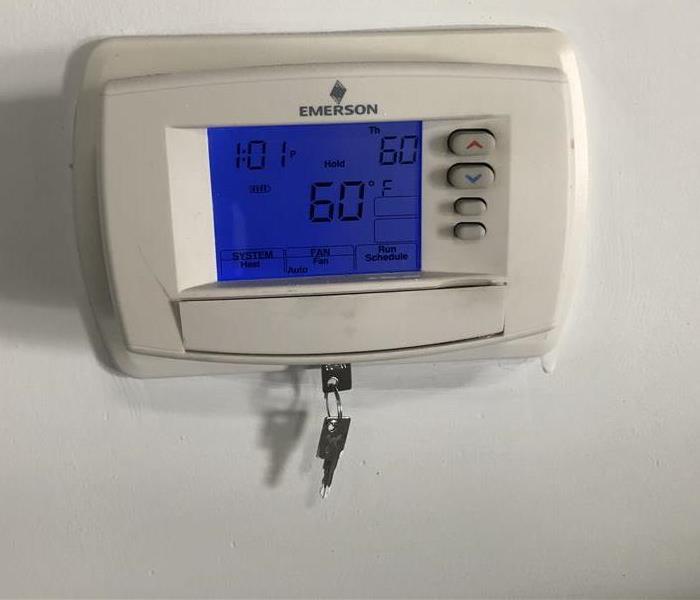 Keep your thermostat set at 55°F or higher.
Keep your thermostat set at 55°F or higher.
Our Livonia weather can be unpredictable. The new year has started out with a mix of 40°F and 20°F temperatures.
Now with the weather forecast showing temperatures will drop even lower thoughts of taking a vacation for a weekend or week long getaway are tempting.
If you plan on leaving your home it is important to keep the indoor temperature set no lower than 55°F. This will help prevent the air space located inside cabinetry and in basements from dropping to freezing temperatures. The pipes located inside those cabinets need to stay above freezing so they do not burst while you are away.
We hope this little tip will allow you to return from your relaxing vacation to a warm and dry home!
Black Mold
2/2/2018 (Permalink)
Black mold is one of the worst fears you might have as a homeowner. Toxic black mold (Stachybotrys chartarum) grows in common household features such as carpet, drywall, insulation, and sub-flooring. It grows when these household materials have been in contact with moisture. As it grows, it releases spores into the air.
Where to Test for Black Mold
Testing for mold is essential, and you should have a dwelling inspected for black mold before you buy it or sign a lease. If you suspect there may be black mold in your home, or you have never had your home tested, contact SERVPRO of Livonia for professional mold remediation services in the Metro-Detroit area. While many aspects of home-ownership can be handled in a D.I.Y. fashion, black mold is not something to be messed around with.
Carpet
Black mold loves to live on the carpet. Dust collects in carpet fibers and those same fibers trap the humidity and dampness that enables mold to grow. Carpets in below-ground levels are especially susceptible to mold as there is more humidity there.
Carpet mold is often not visible from the surface, except in severe cases, which makes testing for it necessary even if you don't see any evidence.
Air Conditioning and Heating Vents
Air conditioning and heating vents actually create ideal conditions for black mold to grow. Dual-purpose vents that both heat and cool your house raise that risk as they are in constant use.
When you have mold in your air vents, those spores are being circulated throughout your home. The sooner you can perform mold remediation procedures, the better. SERVPRO of Livonia has a 24-hour mold emergency service hotline to quickly begin the process of cleaning your air vents.
Drywall
Mold is unfortunately common in drywall, as it traps humidity. This is especially common as the seasons change from winter into spring. Because of the nature of it, mold in drywall is rarely visible except in severe cases. For this reason, it's imperative to have a potential home be tested for mold in the walls before you sign a lease or put down a deposit.
Property Ownership
1/31/2018 (Permalink)
After a water emergency strikes in a commercial building you own, your immediate concerns involve both personal losses along with the added stress and responsibility to get all of your tenants back in business or living comfortably in your units again. SERVPRO offers the resources locally and on a national level to rehabilitate even a complex commercial water damage scenario. We exceed your needs both to repair your property and also to restore the trust the companies and individuals have invested in your professional commercial management.
Although burst pipes or a roof leak may start in a confined area of your office building, apartment complex or warehouse space, the resultant flood and seepage of water can spread far from the original breach. Many if not all of the businesses or residents renting from you are in peril of losing personal and professional property as well as their means to make a living if you do not take immediate steps to solve your Orlando commercial water damage. Even if the water overflow can be traced to the negligence of a tenant, you as the owner are charged with the task of protecting your building and fixtures and ensuring that all those who live in or operate a business within your commercial property have the use and quiet enjoyment of their leased premises quickly restored.
SERVPRO understands how important it is to limit the downtime of your and your tenants’ business operations. We make every effort to clean and dry the structure quickly, staging the restoration process with an eye to reestablishing business operations even before the entire remediation is accomplished if appropriate and safe. Preventing secondary damage from contaminated water is a major goal, made more attainable if we are involved as soon as possible in the process. Our services for you and your tenants can also include a pack out and detailed inventory of documents soaked by the water. We follow up with our state of the art procedures for saving and drying paperwork, books, pictures and other crucial work products you and your lessees may have feared would be lost due to the water infiltration.
If your commercial property has suffered water damage, call SERVPRO of Livonia immediately. We can be reached at 734-744-8104, twenty four hours a day every single day of the year, our technicians eager to return you and your renters to business as usual swiftly as possible.
Winter Storm Preparation
1/30/2018 (Permalink)
Heavy rain and freezing temperatures, damaging winds, sleet and snow can cause serious and costly property damage to your home or business if you are not ready. You can't control the weather however you can make provisions and be prepared to help take the sting out of winter weather.
Protect your property by taking these precautions before colder weather hits to help prevent costly damages from old man winter.
- Inspect tree limbs and branches around your property. Strong winds, heavy rain, snow and ice can cause branches to fall, which could potentially lead to damages to the structure and even cause personal injuries.
- Inspect the roof, water pipes, and gutters to ensure they are in proper working order. Direct gutter downspouts away from your structure. Clear all debris from gutters. Leaves, pine needles and other obstructions can cause a damming effect, which can lead to roof damage and interior water problems.
- Inspect walkways and parking lots for proper drainage to alleviate potential flood hazards.
- Inspect all handrails, stairwells, and entryways to prevent potential slippery or hazardous areas. Install mats or non-slip surfaces. Post caution signs where water could be present.
- When temperatures dip below freezing, allow faucets to drip to help prevent pipes from freezing. Leaving cabinet doors open allows warm air to circulate around pipes located underneath cabinets helping to prevent freezing. If the structure has outdoor faucets, consider shutting water off at the main valve in the basement or crawl space. Once the valve is off, open the outdoor faucet to ensure it drains, preventing any remaining water from freezing in the pipe.
- Ask SERVPRO of Livonia about completing an Emergency READY Profile® (ERP) for your business. The ERP is a no-cost assessment of your facility and provides you with a plan to get back in business fast following a disaster.
Storm Damage Restoration
1/30/2018 (Permalink)
Hit hard by mother nature?
SERVPRO of Livonia provides 24-hour wind and storm damage restoration service in Livonia.
To get help fast, call SERVPRO!
Property damage caused by severe weather can be devastating to your family or business, and repairing it can be a complex undertaking. To get storm damage repair completed quickly and safely, you need a restoration service company that specializes in bringing your home back to its preloss condition.
SERVPRO of Livonia provides specialized emergency cleanup and restoration services in Oxford to bring your property back to normal with minimal interruption. We can handle any damage due to severe weather, including:
- Thunderstorms
- Lightning Strikes
- Hurricanes
- Tornadoes and high winds
- Hail and ice storms
- Freezing weather and ice dams
SERVPRO has successfully rebuilt tens of thousands of wind-damaged households through the years. It is in situations like these that our team’s specialized skill sets are required. Rebuilding part of a home is very different from a new construction facility. Building materials, design, and finishes must all be matched to the remaining structure, while moisture remaining in the building components may need to be addressed as well.
SERVPRO of Livonia is licensed and insured contractors that are available 24 hours a day. Call SERVPRO (734)744-8104 or find us on the web for your best storm damage restoration costs inspection estimate! Save money and time on Storm Damage Restoration Costs in Livoinia.
Natural Disaster - Flooding
1/16/2018 (Permalink)
According to the National Weather Service (NOAA), “Approximately seventy-five percent of all Presidential disaster declarations are associated with flooding.” NOAA lists the most common flood hazards in the United States as:
- Flash Flooding
- River Flooding
- Storm Surge and Coastal Inundation from Tropical and Non-Tropical Systems
- Burn Scars/Debris Flows (Caused by Wildfires)
- Ice/Debris Jams
- Snowmelt
- Dry Wash (Caused by heavy rainfall in dry areas)
- Dam Breaks/Levee Failure
Just because you haven’t experienced a flood doesn’t mean you won’t in the future. In fact, 20% of all claims paid by the National Flood Insurance Program (NFIP) were for policies in low-risk communities. On average, floods cost $3.5 billion in annual losses in the U.S., and commercial flood claims average more than $75,000 (NFIP).
When catastrophic water damage happens to you, SERVPRO Livonia Professionals can help. They can help you prepare ahead of time with an Emergency Ready Profile (ERP), or respond to any size disaster to begin cleanup and restoration to get you back in business as soon as possible.
Your local SERVPRO of Livonia Professionals are ready to help make it “Like it never even happened.”
What to do about a mold problem...
1/16/2018 (Permalink)
What’s the Difference?
Since microscopic mold spores exist naturally almost everywhere, indoors and outdoors, removing all mold from a home or business is impossible. Some restoration businesses advertise “mold removal” and even guarantee to remove all mold. This is a fallacy.
A qualified restoration company understands the science behind mold and mold growth. SERVPRO Franchise Professionals have the training and expertise to remediate the mold in your home or business. Mold remediation focuses on getting mold levels back to normal, natural levels.
Every mold damage scenario is different and requires a unique solution, but the general mold remediation process stays the same.
Step 1: Emergency Contact
Step 2: Inspection and Mold Damage Assessment
Step 3: Mold Containment
Step 4: Air Filtration
Step 5: Removing Mold and Mold-Infested Materials
Step 6: Cleaning Contents and Belongings
Step 7: Restoration
Understanding Mold
When water intrudes into your property, mold growth can start in as little as 48 hours. Consider the following mold facts: Mold is present almost everywhere, indoors and outdoors.
- Mold spores are microscopic, float along in the air, and may enter your home through windows, doors, or AC/heating systems or even hitch a ride indoors on your clothing or a pet.
- Mold spores thrive on moisture. Mold spores can quickly grow into colonies when exposed to water. These colonies may produce allergens and irritants and have the potential to cause other health effects.
- Before mold remediation can begin, any sources of water or moisture must be addressed. Otherwise, the mold may return.
- Mold often produces a strong, musty odor, and that odor can lead you to possible mold problem areas.
- Even higher-than-normal indoor humidity can support mold growth. Keep indoor humidity below 45 percent.
What to Do:
- Stay out of affected areas.
- Turn off the HVAC system and fans.
- Contact a SERVPRO Franchise Professional for mold remediation services.
What NOT to Do:
- Don’t touch or disturb the mold.
- Don’t blow air across any surfaces with visible or suspected mold growth.
- Don’t attempt to dry the area yourself.
- Don’t spray bleach or other disinfectants on the mold
Does your business have a plan?
1/15/2018 (Permalink)
How quickly your company can get back to business after a tornado, fire, or flood often depends on the emergency planning before the devastation of these tragedies. The regular occurrence of natural disasters demonstrates the importance of being prepared for any emergency. While each situation is unique, your organization can be better prepared if you plan carefully, put emergency procedures in place, and practice for all kinds of emergencies. Protect your business investment and give your company a better chance for survival with the following preparation:
Develop a Business Continuity Plan
Your organization's risk needs will vary depending on the specific industry, size, scope, and location. Begin by reviewing your business process flow chart, if one exists, to identify operations critical to survival and recovery. Carefully assess your internal and external functions to determine which staff, materials, procedures, and equipment are absolutely necessary to keep the business operating. You should also establish procedures for succession of management.
Review Insurance Coverage
Inadequate insurance coverage can lead to major financial loss if your business is damaged, destroyed, or simply interrupted for a period of time. Insurance policies vary; check with your agent or provider about things such as physical losses, flood coverage, and business interruption. Understand what your policy does and does not cover.
Prepare Your Emergency Plan
Your employees and co-workers are your businesses' most valuable asset. Communication is central before, during, and after a disaster. Include emergency information in newsletters, on your company intranet, in periodic employee e-mails and/or other communication tools.
Practice the Emergency Plan
Some disasters will require employees to leave the workplace quickly. The ability to evacuate workers, consumers, and visitors effectively can save lives. If your business operates out of more than one location, establish evacuation procedures for each individual building. If your company is in a high-rise building, an industrial park, or even a strip mall, it is important to coordinate and practice with other tenants or businesses to avoid confusion and potential gridlock.
Secure Your Facility and Equipment
Install fire extinguishers, smoke alarms, and detectors in appropriate places. Secure all entry and exit points and plan for mail safety. Plan what you will do if your building, plant, or store is not usable. Secure valuable equipment.
Why IICRC is important to you...
1/15/2018 (Permalink)
IICRC is the Institute of Inspection Cleaning and Restoration Certification. There are many courses and certifications that SERVPRO technicians have obtained to guarantee better service for our customers. The IICRC sets industry standards across the board. They cover everything from cleaning techniques to fire and water damage restoration. They also do extensive training on Mold Remediation. To stay IICRC certified, there are constant re-education courses required.
SERVPRO of Livonia, requires that their lead technicians are IICRC certified. For the last 4 years we have had an IICRC technician on every single job site for the duration of the project, to make sure you, the customer, receives the highest quality of service.
When a SERVPRO IICRC Certified technician enters your home, they are equipped with in depth knowledge of how to assess the damage that has occurred, and then the best tactics to not only stopping further damage but restoring the items you currently have.
SERVPRO Livonia, holds itself to the highest standards in the industry to best serve our customers and our community.
Finding Hidden Mold
1/11/2018 (Permalink)
Modern building materials including wood, drywall, grout, and wallpaper are all appealing food sources for mold. All they need is a little moisture, and mold spores can take hold and create an entire colony hidden behind the walls, beneath the floor, or above the ceiling in your home. With homes built the way they are today—tightly, with energy efficiency in mind—water from a leaky roof or vapor from the dishwasher can easily get trapped inside. This creates a recipe for disaster, one that could cause health effects.
Finding Hidden Mold in Your Home
Hidden mold can also destroy home value by damaging its structural integrity. It’s something you want to get rid of as quickly as possible.
If you think you might have hidden mold growing in your home, use these tips to find it:
Hire a professional: The easiest and best way to find out if your home has hidden mold is the hire a professional mold remediation company like SERVPRO. We know how to quickly and successfully find and eliminate mold in your home while causing the least amount of disruption to your daily life possible. Some of the other methods listed below can be challenging to perform without the help of an experienced pro.
Check the roof for leaks:Visit the attic and pull up insulation to check for hidden mold there. Roof leaks can also result in ceiling water stains and sagging drywall, other indicators for hidden mold growth.
Check for leaky pipes: This obvious sign of water intrusion could be causing mold growth on the other side of the wall. Examine all fixtures for leaks, including the bathroom and kitchen sinks, toilet, refrigerator, washing machine, and all other water and sewer supply lines.
Test the humidity with a hygrometer: If any rooms have relative humidity higher than 60 percent, hidden mold is likely in that area.
Examine the inside of cabinets: Remove drawers and look thoroughly at all wood surfaces in kitchen and bathroom cabinetry. You may even need to remove the cabinets in their entirety to examine the wall and floor beneath the installation. This, however, will most likely require the help of a professional.
Have the ductwork inspected: Mold can grow inside the ductwork and spread spores all over your home. An inspection from SERVPRO may reveal the problem.
Have the ceilings, walls, and floors tested for dry rot: Elevated internal moisture and dry rot is an indication that hidden mold is growing there.
Remove sections of wallpaper: Cut one-inch square pieces from the wallpaper every several feet. Examine the backside of the samples for mold growth.
Cut holes in the drywall: This can be seen as a drastic move by many homeowners, but if you have hidden mold behind the walls in your home, it’s important that you find it as soon as possible. Use a flashlight to examine the wall or ceiling cavity. Smell the air and try to pick up on any musty odors that indicate mold growth.
SERVPRO has the expertise and knowledge required to remove mold from the basement, crawlspace, attic, or anywhere else it has started growing in your home or business. Call 734-744-8104 today if you suspect mold anywhere in your home or business.
Why not to use bleach to clean mold...
1/8/2018 (Permalink)
Chlorine Bleach is often regarded as the answer for stopping mold growth and removing the mold. However, this is a myth. Bleach does not exonerate mold. Here are three reasons why bleach is not the answer to mold, and should never be used to clean a mold contaminated area.
1. Bleach Loses Effectiveness over Time
Chlorine bleach can dissipate rapidly, causing the bleach to be less effective. Over time this occurs because chlorine can evaporate and even faster in areas that are above room temperature. When the chlorine disappears, the bleach bottle turns into a bottle of salt water.
2. Bleach can actually contribute to mold growth
Chlorine bleach was made to clean surfaces, therefore can only kill surface bacteria and mold. This is due to bleach’s ion structure, which prevents the chlorine from penetrating porous material such as wood and drywall. When mold grows in porous areas, the enzyme’s roots grow deep within the material, rendering the bleach ineffective of exterminating the mold. The bleach can only remove the green stain from the mold, allowing surface to appear clean. But underneath the surface, the water component of the bleach penetrates and helps the internal roots to continue to grow, causing mold to reappear.
3. Bleach is Toxic
Bleach emits harmful fumes that pollute the air we breathe and can cause health effects to humans and even pets. Also research shows that household bleach is one of the leading causes of accidental poisonings in the United States.
Dorm Safety
1/5/2018 (Permalink)
As college students head back to their dorm after winter break, remember these tips to stay safe and keep those around you safe.
Learn the building’s evacuation plan.
If you’re living on campus, chances are your dorm will have an emergency evacuation plan and all buildings on campus should have an evacuation plan posted on each floor. Make sure you are familiar with these plans.
If you live off campus, have an escape plan of your own with at least two ways out of each room.
Don’t overload your room’s electrical outlets.
Most electrical outlets in dorms are designed to handle specific amperage. It’s best not to try to push them to their capacity by using too many multi-plug devices. If you ever notice any scorched marks or burning odors around an electrical outlet, stop using that outlet and inform someone of the problem right away.
Cook with care.
Be careful when cooking in your dorm or in the dorm’s community kitchen. If you do not have a kitchen in your dorm, then you should follow the school’s guidelines on what sort of plug-in cooking equipment is permitted for use in the dorms. Always be careful with electric frying pans, toasters, toaster ovens, microwaves, etc. Never leave your dorm when cooking appliances are in use.
Respect open flame policies.
Most schools don’t allow you to smoke or burn candles or incense in the dorms. If you do smoke, be sure to do so in the designated areas on campus (most likely away from buildings). Avoid burning candles or incense in your dorm room. If you burn them for the smell, try using essential oil diffusers to create a pleasant aroma in the dorm. If you do still choose to burn candles or incense in your dorm, never leave them unattended and keep them away from flammable materials.
Don’t tamper with fire safety features in your dorm.
Most dorms should have smoke detectors. It is important that you do not cover them with any decorations in your dorm. Additionally, do not remove the batteries in your dorm’s smoke detector. It will send a signal to Public Safety to investigate the source of the problem. If your dorm has a sprinkler system in place, don’t hang any decorations on it. Sprinklers are there to help put out a fire before firefighters can get there. They are especially important if your dorm is on an upper level as it can be more difficult for firefighters to get to the flames.
Be mindful of clutter and how you decorate your dorm.
While decorating a dorm room can display your personality or bring some of home to school with you, it can also become potential fuel for a fire. Every poster or tapestry you hang on the wall, or piece of decor you hang from the ceiling, can be considered a fire hazard. Some schools may limit the amount of wall space that can be covered in your dorm, or may prohibit hanging things from the ceiling. Even if there are no restrictions, it would be wise to limit the amount of decor you hang in your room as well as to keep clutter to a minimum. Additionally, avoid draping materials over hot items like lamps that could potentially cause ignition. Furniture should also be kept away from the room’s heat source to reduce the risk of fire.
5 Things to Include in Your Fire Escape Plan:
1/4/2018 (Permalink)
- Draw a Map of Your Home.
Draw a map of each level of your home. On your map make sure to show the following:
- All doors,windows, & smoke alarms.
- 2 ways to get out of each room. Check to make sure you can open all doors and windows easily.
- Mark a safe location to meet near the front of your home.
- Have 2 Ways Out of Each Room.
When making your plan try and have at least 2 ways out of each room. Also, make sure each person can open all the windows and doors.
- Know How to Keep Yourself Safe When Escaping!
There are multiple different scenarios that can happen when you’re trying to get out of your home, so make sure you and your family know how to handle them.
A few things to know and practice are:
- Crawling low to the floor to avoid toxic smoke.
- Closing doors on your way out to help slow the spread of fire, giving more time to safely escape.
- Stop, Drop, & Roll if clothes catch on fire.
- How to call 9-1-1 to get help.
If the fire prevents you from escaping, here are some tips…
- Use duct tape or towels to seal the door cracks and cover air vents to help keep smoke from coming in.
- Call for help, or if you don’t have a phone try using a whistle to alert neighbors.
- Wave a flashlight or light-colored cloth at the window to let the fire department know where you are located.
- Get Out & Stay Out!
Designate a meeting location a safe distance in front of your home – like at the end of the driveway, on the sidewalk, or near a certain tree. You want it to be near the front of your home so the firefighters will know that you’re out.
Be sure to never go back into a burning building for any reason! If someone is missing tell the firefighters right away since they are equipped to perform rescues safely.
- Have a Fire Drill Twice a Year!
Fire drills aren’t just for schools, but for your home too!
It is recommended that youprepare and practice your fire escape plan twice a year with everyone in your household, including children.
Water Contamination Terms
1/3/2018 (Permalink)
Water from sewer system backups should be considered very dangerous. The water is grossly unsanitary and may contain bacteria and viruses that can cause health effects. Special training and equipment is necessary to safely clean this type of contamination.
There are three major types of contaminated water.
Category 1: “Clean Water”
This is water from a clean source, such as a broken clean water supply line or faucet. If left untreated, category 1 water can quickly degrade into category 2 or 3 water depending upon such factors as time, temperature and contact with contaminants.
Category 2: “Gray Water”
This water has a significant level of contamination that could cause health effects if ingested. Sources for category 2 water may include washing machine overflow; toilet overflow with some urine, but no feces; or dishwasher overflow.
Category 3: “Black Water”
This water is grossly unsanitary, can cause health effects, and any contact should be avoided. Sources for category 3 water could include flooding from rivers or streams, water from beyond the toilet trap, water from the toilet bowl with feces or standing water that has begun to support microbial growth.
SERVPRO of Livonia will inspect the contaminated water to determine the type of water and then plan the appropriate response to safely restore your home or business.
Car Emergency Kit
1/2/2018 (Permalink)
You may have a home emergency kit or a home first aid kit, however, a car emergency kit can be just as important to keep. May people spend large amounts of time in a car, expecting them to work at every use. This is a dangerous truth that can be believed as cars cannot be reliable all the time. It is when driving in the worst weather conditions or not in a great area that a car can lose functioning.
A car emergency kit is something that you may have never thought about until the exact time you need it.
Vehicle breakdowns happen and even a car service membership or calling for help may not be an immediate relief to the problem. Sometimes it can take hours for a car emergency to be responded to. This is why we suggest having a car emergency kit at hand in your vehicle. The following are items to keep:
- First Aid Kit
- Reflective warning triangles
- Tire gauge
- Foam tire sealant
- Jumper cables
- Flashlight/extra batteries
- Gloves
- Rags
- Maps
- Tire chains
- Duct tape
- Tow strap/rope
- Multipurpose utility tool
- Rain poncho
- Drinking water
- Nonperishable snacks
In the winter add:
- Snow shovel
- Blanket
- Cat litter
- Windshield ice scraper
An emergency kit for your car can be purchased or it can be homemade, either way it is a great way to keep safe on the road.
Cleaning the Fridge – Avoid water damage
1/2/2018 (Permalink)
The household refrigerator is a major appliance that is often forgotten about when cleaning the kitchen. It is important to keep up to date on a cleaning schedule because it can cause major problems to the home. Mold can form inside and around the fridge where there is moisture, the hose to the water dispenser can leak, the ice dispenser can harbor mold and yeast—keep your family safe by following these cleaning tips:
Inside:
Shelves and drawers—
- Remove items from the shelves and drawers.
- Wipe down all shelves as well as any sticky and drippy containers with baking soda and water solution. Dry and return items.
- Get rid of any food that has gone bad or that will not be consumed.
Gasket(rim around doors that helps seal the cold in)—
- Wipe the gasket/seal with a mild detergent solution. Dry with a clean cloth.
Outside:
Doors—
- Wipe down the doors, edges, handle and top of the refrigerator with mild detergent solution. Dry.
- For stainless steel refrigerators, apply coconut oil with a soft cloth. Buff to remove excess.
Water dispenser—
- Because yeast and mold can build up on the dispenser spout, it should be cleaned every month or as needed.
- For added safety, make sure to replace external water filters as recommended by the manufacturer.
- Make sure the water line leading to the water dispenser is attached properly to avoid water damage.
Ice dispenser—
- The ice dispenser drawer actually can harbor mold and yeast.
- To clean the ice bin, turn the ice-maker off, remove the bin and discard the ice. Using lukewarm water and a mild dish detergent, wash the bin, rinse well and then dry.
Back of fridge—
- Vacuum under fridge and the coils on the back. Be careful not to puncture the coils.
Michigan Winter and Ice
12/29/2017 (Permalink)
Winter has arrived and it is important to protect your home from leaks and water damage. Over time ice dams can form along gutters and along a house’s roof. Ice dams prevent melting snow from draining off the roof, water then backs up behind the dam leading to a leak in the home. This can cause damage to walls, ceilings, insulation and other areas.
What causes Ice Dams? Ice dams from along the roof’s edge, usually above the overhang. Heat and warm air leaking form the living space or office space below melts the snow, then trickling down into the colder edge of the roof and it re-freezes.
Along with Ice Dams, icicles are another sign of poor roof ventilation and poor insulation in the home. Warm, moist air from inside the home can move upwards and leak around ceiling lights. Poorly insulated ceilings around attic openings then cause warm air to be trapped in the attic.
Hiring - Restoration Technicians
12/29/2017 (Permalink)
Our mission is to approach Water, Fire and Mold Damaged structures and restore them to the point, "Like it never even happened." We are SERVice PROfessionals. Attention to detail, the ability to communicate with customers in a polite professional manner, and to go into every job with tact are key attributes we search for in all of our candidates.
Physical Requirements/Working Conditions:
This position involves application of cleaning solutions and exposure to moderate noise levels when operating restoration equipment. Performing the physical activities of this position require considerable use of whole body, such as climbing, lifting, balancing, walking, stooping, and handling of equipment. Position requires the ability to lift up to 50 lbs frequently. You also need to be able to work in high places and in confined or tight spaces. You must be capable of working in fire, smoke, and/or water damage environments that have potential for mold and mildew. With the appropriate equipment, cleaning bodily fluids and excrements, along with bugs and other materials will be required. If you have dust allergies and sensitivity to odors, this may not be the best fitting position.
Requirements:
- Must have a professional appearance and great attitude.
- A valid driver's license with a clean driving record.
- Proficient in using an iPad for digital paperwork and documentation. (DryBook experience preferred but not required)
- Ability to pass a criminal background check with no felony convictions and able to pass drug test.
- Because we provide 24 hour emergency services, you must be willing to be on call on a rotational basis.
- Must work well within a team environment to build each other up and be supportive.
- Must have reliable transportation to and from work.
Responsibilities:
- Provide excellent customer service.
- Perform on-site production services including water extraction, demolition, fire clean-up, and contents inventory/packing.
- Develop production expertise: services, products, equipment, and documentation.
- Leave jobsite with a clean and orderly appearance.
- Follow the SERVPRO uniform and conduct policy.
- Must be dependable in attendance and very punctual.
- Xactimate sketching skills are preferred but not required.
Construction experience and IICRC certifications are a plus.
New Year's Eve Bubbly Safety
12/29/2017 (Permalink)
Follow these five tips to prevent serious injury or home damage when opening your bubbly this New Year’s Eve:
1) Just chill.
Champagne has tons of bubbles filled with gas that expand when warm. With each degree in temperature, pressure builds that can make a cork fly out unexpectedly. To preserve your eyesight (and the taste of your bubbly), always chill your Champagne in the fridge or on ice to about 45 degrees.
2) Don't shake, rattle…or point.
While it looks like fun in the movies, don't shake the bottle. Agitating Champagne increases pressure. Also, don't point the bottle at anyone! Beyond being impolite, it could cost someone an eye.
3) Control the cork.
After tearing off the foil, hold down the cork with the palm of your hand while removing the wire hood. Never use a corkscrew to open a bottle of Champagne or sparkling wine.
4) Towel, tilt, twist.
Place a towel over the entire top of the bottle and grasp the cork. Point the bottle at a 45-degree angle away from yourself and any bystanders. Slowly and firmly twist the bottle at its base while holding the cork — not the other way around — to break the seal. Counter the force of the cork using slight downward pressure just as the cork breaks free, creating the signature pop.
5) Cheers!
Time to toast. Clink carefully to avoid breaking any glasses. Here's to celebrating responsibly! If you do sustain an eye injury from a champagne cork, seek immediate medical attention from an ophthalmologist.
Happy New Year! Here’s to 2018!
Frozen pipe Damage
12/26/2017 (Permalink)
Michigan is known to have harsh winters with extreme change in temperatures. This change in temperature affects water pipes as the water expands in the cold as it freezes. As the water expands into ice it pressures the pipes, without anywhere for the pressure to release the pipe has no choice but to burst. Any pipe in an unheated or temperature controlled area is prone to freezing and bursting. The pipes that are most susceptible to this situation are sprinkler system lines, water lines underground, exterior spigots. To avoid issues with pipes it is important to keep your home or business to 55 degrees or warmer. It may also help to open doors inside to help airflow throughout the building.
If you experience frozen pipes make sure to call SERVPRO of Livonia. We would be happy to assist with your water damage needs.
Emergency Ready Profile
12/21/2017 (Permalink)
At SERVPRO Livonia, we encourage our commercial customers to have an Emergency Ready Profile. An ERP is a great tool for when disaster strikes. SERVPRO has recently released a mobile app to support this program. The Emergency Ready Profile app contains all of the local emergency contact information and work approval options.
This means, as a business, any employee will know what to do in case of water or fire damage. With a work approval available through the app, SERVPRO can start working the second they are on site.
The best time to plan for damage events is not after an event happens, but well before. No one ever plans on walking into work and then walking into a disaster, but you can be ready for it. When damage strikes, you can be ruined or you can be READY! Contact us today to set up your ERP appointment.
Winter Storms in Michigan
12/21/2017 (Permalink)
As we welcome winter in Michigan we know that the weather can change in the snap of a finger. When a blizzard comes into town we must make sure we know what we are dealing with. A blizzard is a severe snowstorm characterized by strong sustained winds of at least 35 Miles per hour and lasting for an extended amount of time (usually 3 hours or more). A ground blizzard is a weather condition in which snow is not actively falling but loose snow on the ground is blown by strong winds.
Damage from blizzards can be severe and costly if not properly taken care of. Power outages can occur due to strong winds and heavy snow. Temperatures quickly drop below zero, especially with the wind chill. Ice, snow, and winds can cause falling trees, roof cave-ins, and windows breaking.
Water Damage Timeline
12/20/2017 (Permalink)
Flooding and water emergencies don’t wait for normal business hours and neither do we. SERVPRO of Livonia provides emergency water, fire, and mold restoration services 24 hours a day, 7 days a week—including all holidays.
Faster To Any Size Disaster
Flooding and water damage is very invasive. Water quickly spreads throughout your home and gets absorbed into floors, walls, furniture, and more. SERVPRO of Livonia arrives quickly and starts the water extraction process almost immediately. This immediate response helps to minimize the damage and the cleaning and restoration costs.
Need Emergency Service? Call Us 24/7 – 734-744-8104
Water Damage Timeline
Within Minutes
Water quickly spreads throughout your property, saturating everything in its path.
Water is absorbed into walls, floors, upholstery, and belongings.
Photographs, books, and other paper goods start to swell and warp.
Hours 1 - 24:
Drywall begins to swell and break down.
Metal surfaces begin to tarnish.
Furniture begins to swell and crack.
Dyes and inks from cloth and paper goods spread and stain.
A musty odor appears.
48 Hours to 1 Week:
Mold and mildew may grow and spread.
Doors, windows, and studs swell and warp.
Metal begins to rust and corrode.
Furniture warps and shows signs of mold.
Paint begins to blister.
Wood flooring swells and warps.
Serious biohazard contamination is possible.
More Than 1 Week:
Restoration time and cost increase dramatically; replacing contaminated materials and structural rebuilding may be extensive.
Structural safety, mold growth, and biohazard contaminants pose serious risks to occupants.
Protecting Your Home from Invasion
12/19/2017 (Permalink)
Keeping your home safe is key. Here at SERVPRO Livonia we deal with some situations that involve a home invasion in which the burglars have left water running, causing water damage. Burglars do not care what happens to your home. Be proactive and check out these tips to keep your home safe:
- Keep hedges and trees trimmed so it is difficult for a burglar to hide in them or climb up trees to get to second stories.
- Keep car keys on a nightstand instead of a key bowl or hook. Providing easy access to keys is a no brainer for us but it is like handing the keys right over to a burglar.
- Routinely check to make sure your windows are locked and secure; especially after having repair crew in your home
- Store your spare key to the house with a neighbor or friend. Hiding a key under the mat or a rock is too obvious to a burglar.
- Make sure all dead bolts are locked on all doors and that the garage door is closed.
- When setting up a new purchase like a 60 inch TV, cut up the packaging so it will fit inside a recycling bin or put out on the curb the morning of pick-up. Burglars will notice a large TV (or other appliance) box sitting out on the curb.
- When out of town have a neighbor or friend pick up mail or any packages so they are not piling up.
- Keep your porch light on all night to keep it from looking like nobody is home. You could also install timers on lights in your home for days you do not arrive home until after dark.
Oven Fires
12/18/2017 (Permalink)
Oven Fire
Here at SERVPRO Livonia we had a call come from a house fire due to an oven malfunction.
If you have never experienced an oven fire, here are some tips on how to handle this emergency situation.
- Leave the oven door closed.
- Turn off the oven and allow the fire to burn out on its own.
- If it does not go out on its own, leave the house and call 911.
- If it does go out, then open your windows.
- Carefully open the oven door after ½ an hour has passed.
- Allow the smoke to clear before determining the cause of the fire and possibly resuming cooking.
Although Step 1 may seem incorrect, opening the door will only cause the fire to expand. By keeping the door closed and turning off the heat, you are starving the fire, since it can’t burn without oxygen.
Disaster Recovery - Commercial
12/15/2017 (Permalink)
Did you know that SERVPRO helps with storm disaster relief? We have a specialized Disaster Recovery Team that comes to the rescue when our country is experiencing serious trauma. No job is too big for SERVPRO with our community of over 1500 nationwide franchises that are ready to help and restore the destruction to make it like it never even happened.
SERVPRO Livonia was in Texas this year helping with the disaster recovery from Hurricane Harvey. We took down a team of technicians and our gear to help those in desperate need.
The SERVPRO Disaster Recovery Team can provide help whether you're dealing with a tornado, hurricane, blizzard or flood. Available 24 hours a day and 365 days a year, SERVPRO Franchise Professionals are prepared for the unpredictable.
Recent mobilizations of the National Catastrophic Storm Response Teams include:
- 2017 Harvey
- 2014 Polar Vortex
- 2012 Sandy
- 2010 Nashville floods
- 2008 Ike
- 2007 Chicago floods
- 2007 Ohio floods
- 2007 California wildfires
- 2005 Katrina/Wilma/Rita
Fireplace Tips and Safety
12/14/2017 (Permalink)
Enjoying a warm, cozy fire requires a clean, safe fireplace. Here are some tips for keeping it that way:
- Fireplaces should not be used as furnaces. Use a fireplace for a short-duration fire — no longer than five hours.
- Keep the glass open to allow air to be drawn up to cool the chimney, but keep the screen closed to prevent sparks from jumping onto the carpeting.
- Never leave a fire unattended when children are in the house. Adults, even if near, should not allow children to play near or with fire tools and equipment.
- Open a window when using the fireplace to prevent the room from becoming smoky. The air coming in from the window will go up the chimney.
- Before making a fire, open the glass doors, pull aside the screen curtains, and place the kindling, newspaper and logs inside. Next, open the damper and a window. The window needs to be open only a few inches. You can check to make sure the smoke will go up the chimney properly by lighting a match, quickly blowing it out and watching the smoke to see whether it's going up and out.
- Keep a nonflammable rug (available at fireplace-supply stores) in front of the fireplace so that sparks won't melt or otherwise damage your carpeting.
- Use fireplace tools to handle burning logs. Never use your hands.
- Use a chimney cap to prevent water damage, to keep animals from nesting and to keep debris from blocking the chimney and causing carbon monoxide to flow into the house. Use a spark arrester to help prevent sparks from flying out, which could start a fire on the roof or lawn.
- Glass doors may develop tough stains from flames and heat. To clean them, make sure the glass doors are cool, then scrape off any thick gunk deposits with a razor blade. Add a squirt of liquid dishwashing detergent to a bucket of warm water, or add a cup of vinegar to a gallon of water. Spray or sponge the cleaner on, and then wipe it away with newspaper (which is lint-free). Another option is to buy glass cleaner at a fireplace store.
- Fireplace coals can remain hot enough to start a fire for up to three days, so always wait at least that long before removing the ashes. At that point, close the damper to prevent cold air in the flue from stirring up excess dust while you're removing the ashes. Be sure to wear a dust mask and open a window in the same room as the fireplace to prevent negative air pressure. Use a shovel to scoop the ashes into a metal container. Store the container far from combustible materials and surfaces and wood floors.
- Never use a vacuum to clean up ashes, because live coals may remain in those ashes.
- Have a certified chimney sweep inspect and clean the chimney when necessary. Have him show you how to check it yourself, too. The chimney should be checked at least once a year or after about 80 fires.
- Shine brass fireplace utensils with Worcestershire sauce and a toothbrush.
- Clean the firebox (the area where the logs burn) at least once a week during the months you use it, when ash builds up. Leave about an inch of ash because it acts as insulation, allowing the coals to heat faster and retain the heat easier. Keep the firebox completely clean during the months when the fireplace is not in use.
- To clean an exterior slate hearth, wash, dry and coat it with lemon oil every six weeks to make it shine. For cleaning exterior brick hearths, buy a brick cleaner at a fireplace shop.
Tips from HGTV.com
Fire Extinguisher in the Home
12/13/2017 (Permalink)
It is recommended that two fire extinguishers be on every floor in a home.
Every household extinguisher is labeled A, B, or C, which tells you the types of fires the extinguisher is effective against. A is ordinary combustibles like wood, paper, and cloth; B is flammable liquids, such as gasoline or cooking oil; and C is live electricity.
ABC Fire Extinguishers, use monoammonium phosphate which is a dry chemical that is able to quickly put out the fire. It is a pale yellow powder that is able to put out all three classes of fire; Class A for trash, wood and paper, Class B for liquids and gases, and Class C for energized electrical sources.
To use a fire extinguisher, remember PASS:
- Pull the pin.
- Aim the nozzle at the base of the fire. Hitting the tops of the flame with the extinguisher won't be effective. ...
- Squeeze the trigger. In a controlled manner, squeeze the trigger to release the agent.
- Sweep from side to side. Sweep the nozzle from side to side until the fire is put out.
Holiday Safety Tips
12/12/2017 (Permalink)
Safety in the home is essential during the holiday season; you want to make sure your close ones are safe and sound. With the hustle and bustle don’t overlook the following tips:
- Do not overload power strips and extension cords. Check the wattage rating on the extension cord before plugging anything into it.
- Inspect holiday light strings each year and discard any with frayed cords, cracked lamp holders or loose connections.
- Turn off Christmas lights, decorations, and blow out candles before going to bed or leaving the house.
- While cooking, do not leave the stovetop or oven unattended.
- When purchasing a live tree, look for freshness and remember to water once in the home.
- If using a furnace or chimney, inspect and make sure they are free from debris.
Fire-Proof Box
12/11/2017 (Permalink)
It is important to keep documents and other objects secure and safe in case a fire starts in your house or business. See some documents and objects we suggest you keep in a fire-proof box.
- Your Will and/or Power of Attorney; You will want to keep the lawyer’s information with the Will so that they will know who to call if they need it
- Original birth certificates
- Social Security Cards
- Property Insurance information (and again, the number of your insurance company)
- Medical information: Doctor’s numbers, prescriptions, etc…
- Passports
- Cash – in case of emergency
- Titles to your vehicles and one spare key for each car
- Title and deed to house with one spare key
- Marriage Certificate
- DVD with household items
- Flash drive with family photos or any information backed up
Keep your fire safe box in a place that your family can find it. Give a copy of the key to a family member or someone you trust.
Mold Damage in Livonia, MI
11/15/2016 (Permalink)
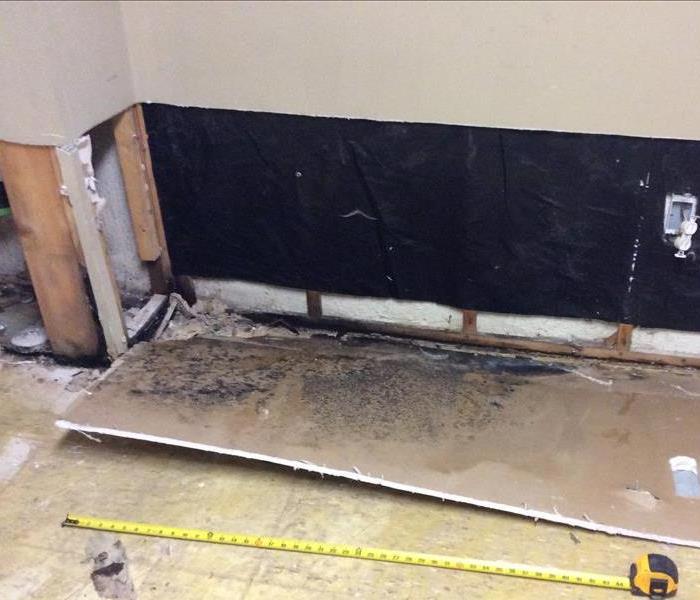 This mold grew behind wall paneling.
This mold grew behind wall paneling.
Mold can cause many health concerns. The worst part is the sneezing, headaches, fatigue, coughs, etc. can all start before the mold is found. Mold grows when there is moisture, warmth and oxygen. Water damage can quickly lead to mold, therefore mold can be hiding in your walls, ventilation systems, and many other areas not easily visible.
Certain molds can be highly dangerous to remove on your own. The reason it's important to hire a mold remediation company to handle all your mold needs. The proper technicians will be able to not only remove the visible molds, but also the spores from which it grows. Certain molds are highly toxic and dangerous to remove without the proper equipment.
SERVPRO mold remediation technicians will be fully equipped with Haz-Mat suits, full respirators and the cleaning materials necessary to handle the full spectrum of mold infestations. Removing mold is not an easy task. It's just one more reason to call SERVPRO of Livonia.
Emergency Survival Kit
11/9/2016 (Permalink)
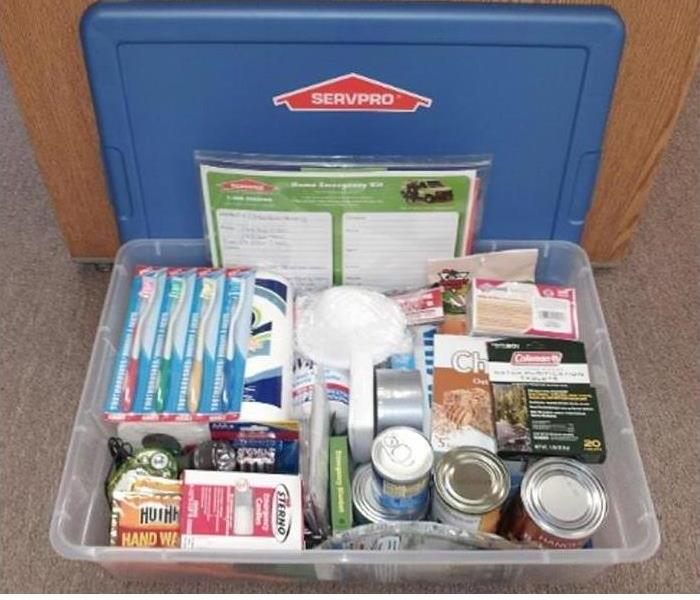 SERVPRO survival kits in preparation for winter.
SERVPRO survival kits in preparation for winter.
With winter approaching, Michigan weather can be extreme. Between major snow falls and wind storms it's important to have an emergency survival kit ready for when the power does go out! These kits can also be stored in cars, for when that icy patch sends you off into a ditch.
Keep in mind, doubling up on essentials like flashlights and radios is a smart move in case something malfunctions.
- Clean water is a great start
- Blankets, Sleeping Bag
- Additional clothes
- Non-perishable food that can be eaten warmed up or cold (if you pack anything that's perishable, make sure to regularly cycle it through to keep it fresh)
- 1-2 Flashlights with extra batteries
- Matches and small candles. Check to make sure there is a metal or some sort of containment for the wax!
- Any necessary medicines (check expiration dates).
- Medical supplies such as band-aides, gauze, Neosporin and rubbing alcohol.
- Lightweight tent
- Personal hygiene items
- Paper goods (napkins, plates, paper towels)
- Manual can opener
- AM/FM radio.
There's always more a person can add to their survival kit. This is a great starting point. If you do lose power during a storm, pipes can freeze or other damage can occur throughout your home. If that is the case, keep SERVPRO Livonia in mind to help you through!
Cleaning Gutters Prevents Water Damage
10/25/2016 (Permalink)
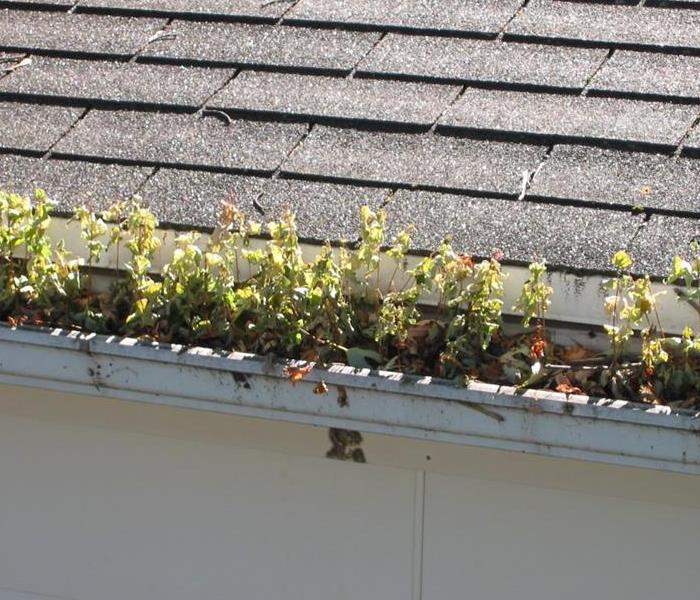 If plants are growing better in your gutter than your garden, it's a sign!
If plants are growing better in your gutter than your garden, it's a sign!
With the leaves falling, it’s time to clean the gutters. We know this is not the most pleasant chore, but it can prevent major water damage. A gutter system is designed to carry water away from the home. A blocked gutter can cause water to back up into your home either through the roof or the basement. We have already seen a few cases this year where water damage could have been prevented if only the gutters had been cleaned. A few steps that are recommended, is using a scope to remove the gunk that has built up, then actually hose down the gutter itself. These steps keep water from standing in the gutters, which can lead to wood rot or bug infestations. Be safe and have an additional person at the foot of the ladder to help with anything that may be dropped or to steady the ladder during a wind gust!
What can I do? The first question in every water damage situation.
10/11/2016 (Permalink)
When your home is flooding with water and you know the damage is starting or already done, a feeling of helplessness sets in. Calling SERVPRO and having our team on it's way, alleviates only a little of that helpless feeling.
As a homeowner, there is only so much you can do, but there are a few things you could know to help us best prepare when we arrive at your home.
- Having a time frame in which the loss occurred. Knowing if it has been days or only a few hours can be a big benefit.
- Knowing the source, whether it's a burst pipe or flood water can determine how much equipment we need to bring. It's also good to know for your own safety. There are degrees of water that no ill equipped homeowner should deal with.
- If electricity will be available. If we know we have to arrange for an outside power source, we can start mitigation must faster.
- Do not use a household vacuum on water.
- Shut off the source of the water if at all possible, and it's safe to do so.
- Remove anything with ink or dyes from the carpet to prevent staining.
These few tips will be a big help when SERVPRO arrives at your water loss. We are here to make it "Like it never even happened."
Emergency Fire Tips
9/29/2016 (Permalink)
There are many do's and don'ts for emergency damage situations. One of the hardest parts of dealing with the aftermath of a fire, is the desire to start cleaning and getting everything back in order. It's very important to NOT start cleaning. In an effort to straighten everything out, you may actually cause further damage. Here are a few do's that you can do. Keep your hands clean and limit movement in the home to prevent further damage. Place dry colorfast towels or old linens on carpeted traffic areas to prevent more soiling. If the electricity is turned off, empty freezers and refrigerators. You are able to wipe soot from chrome on faucets and appliances, but do not clean any appliance that was near the fire without consulting an expert first. SERVPRO of Livonia is dedicated to helping you recover from your fire loss.
Storm Preparation
9/29/2016 (Permalink)
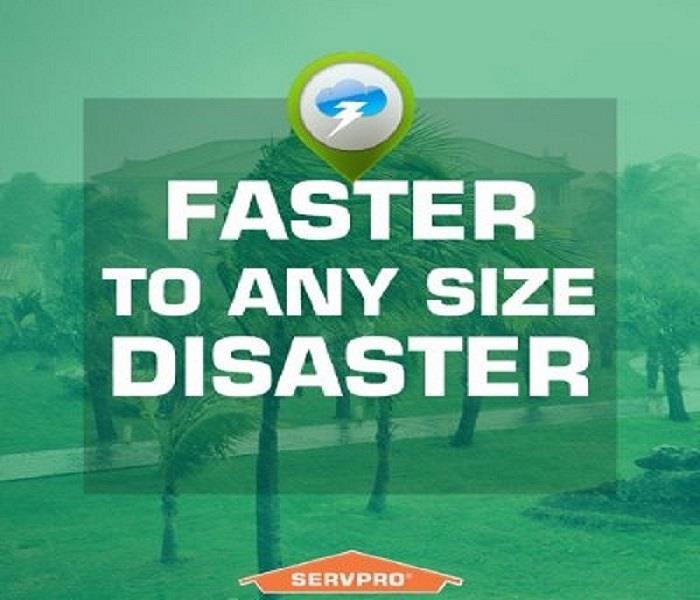 Quick to help in any storm
Quick to help in any storm
SERVPRO Livonia encourages residents throughout the community to take storm damage precautions. With Michigan's intense and unpredictable weather, there are many ways to protect your home from potential damage.
One tip is to have valves on all pipes entering the home. This prevents sewer system back-ups. Any damage involving sewage will requite extensive cleaning and preparation on behalf of the SERVPRO staff. If you do experience a sewage back up into your home, do not hesitate and let us at SERVPRO know right away to minimize the damage quickly.
Make sure with the Fall leaves dropping, to clean gutters and downspouts! We also recommend directing downspouts 5-10’ away from the foundation of the house. A major cause of basement leakage is from overflowing gutters.
Another way to stop water from backing up to the house is to use gravel at the bottom of your downspout.
We hope everyone has a safe and water damage free Fall!

 24/7 Emergency Service
24/7 Emergency Service

